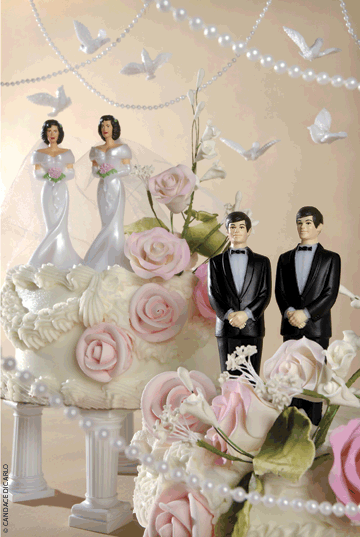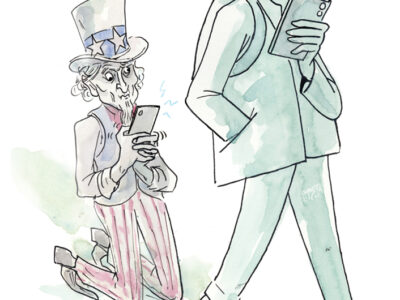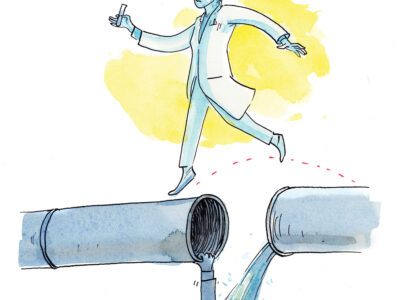
Wedding bells will continue to ring for same-gender couples.
By Robert Schoenberg | Two years ago, in these pages, a jubilant Andrew Martin C’86 reflected on the day he wed his partner at San Francisco’s City Hall [“The Satin Revolution,” May/June 2004]. “We cried, we kissed, we hugged strangers, we took pictures,” Martin wrote in the honeymoon glow of Mayor Gavin Newsom’s decision to license gay marriages. “Now we go forth to live our lives together, and America will quickly see that we are no threat to anybody.”
Since then, gay marriage has received much attention across the country, with wedding toasts interspersed among legal struggles and dire pronouncements about the future of the family. Marriage between people of the same gender was legalized in Massachusetts, but has been challenged in the courts and legislature. Vermont, Connecticut, Maine, New Jersey, and Hawaii allow civil unions or domestic partnerships. Litigation in New Jersey and Maryland is challenging the absence of marriage between two individuals of the same gender.
Many states have approved statutes defining marriage as being only between one man and one woman. Courts in both Tennessee and Nebraska recently sided with efforts to prohibit such unions, while the legislature in Pennsylvania narrowly defeated such a provision. The highest courts of Washington and New York states refused to declare that same-gender couples have the right to marry, referring the plaintiffs to the state legislature.
Although many states and localities—as well as most major corporations—grant benefits to the partners of lesbian and gay employees (Penn was one of the first higher-education institutions in the United States to do so), some benefits are in jeopardy as a result of ordinances designed to limit marriage to a man and a woman. For example, the American Family Association of Michigan recently sued to stop Michigan State University from offering domestic-partner benefits, arguing that the institution is violating a 2004 marriage amendment to the state constitution.
There is a great irony in the opposition to the prospect of gay marriage. Many anti-gay pundits have decried “promiscuous” activity on the part of gay men, identifying such behavior as a reason to condemn homosexuality. Why, they wonder, can’t gay people be “normal” like us? Yet, when a gay man wishes to declare his love for, and fidelity to, his long-term partner, those same critics disparage marriage between two people of the same gender as absurd, evil, or, ironically, abnormal.
On the other hand, some gay and lesbian people oppose marriage, believing it merely imitates and capitulates to heterosexual norms. They feel they do not need the institution of marriage to maintain and manage their primary relationships. However, I assume most of those individuals would not advocate denying the right to marry to gay and lesbian couples who wish to pursue it.
For most, the struggle to achieve the right to marry is not about attempting to change religious doctrine or deny the prerogative of clergy to refuse to officiate at same-gender weddings. What they are seeking, in accordance with the core American value separating church and state, is the right to marry in civil ceremonies. And despite continuing opposition and occasional legal setbacks, their expectation that they will be able to fulfill that desire has grown dramatically in the past quarter century.
When I began in 1982 as director of what is now Penn’s Lesbian Gay Bisexual Transgender (LGBT) Center, no student discussed, except perhaps in an idealistic fantasy, a wedding ceremony with a partner of the same gender followed by forming a family including children. The majority of the young LGBT people with whom I work on a daily basis now express plans to settle down with a primary partner in a sanctioned, maybe sanctified, relationship, and to have children in their lives.
My anecdotal findings have been borne out in a major research project. In May, Penn’s LGBT Center and the national Family Pride Coalition co-sponsored the first-ever academic symposium devoted to reporting research findings regarding LGBT-headed families. At that conference, Professor Anthony D’Augelli from Penn State University shared the results of a study in which more than a hundred gay and lesbian teenagers in and around New York City were interviewed three times over two years. Eighty-two percent of the young men and 92 percent of the young women wished to be in partnered, monogamous relationships within 10 years. Sixty-one percent of males and 78 percent of females indicated that it was “very likely” or “extremely likely” that they would one day marry a same-gender partner. And 52 percent of males and 66 percent of females thought it was “very likely” or “extremely likely” they would someday be raising children.
Penn alumni are very much a part of this trend. At last year’s dinner celebrating the 20th anniversary of PennGALA, the LGBT alumni organization, a stirring talk was given by Evan Wolfson, director of the Freedom to Marry Project, and guests received complimentary copies of his book, Why Marriage Matters: America, Equality, and Gay People’s Right to Marry.
In a further reflection of the changing times, the Gazette’s “Alumni Notes” section has reported an increasing number of same-gender weddings and commitment ceremonies. These include Karen Nicholson-McFadden C’88 and Marilyn Maneely GNu’98, who, with their partners, were plaintiffs in the New Jersey litigation regarding gay marriage. Alas, Marilyn passed away while the case was being reviewed. She was described in the Gazette as “an irreplaceable, gallant fighter for civil rights.” In 1999, Kimberly Acquaviva C’94 SW’95 and Kimberly McGannon were designated the “Millennial Couple” in a contest that attracted almost 5,000 entries, heterosexual and LGBT, sponsored by the wedding website TheKnot.com.
Supporting the right of same-gender couples to marry is by no means limited to LGBT people. The wedding of Jon Herrmann C’00 and Rabbi Lauren Grabelle in April 2005 may have looked like thousands of others, but it was, in fact, very different. The couple was married by the rabbi from a primarily gay and lesbian synagogue who had been Lauren’s mentor. And, as reported in The Philadelphia Inquirer, “in deference to gay people who cannot legally marry, the couple called their ceremony a ‘covenant of love’ and were consecrated one to the other as ‘life partners.’” At the reception they announced a donation to the Freedom to Marry Coalition.
Each February, ALLIES, a popular Penn student organization advocating LGBT civil rights, sponsors Freedom to Marry Day on campus. Two-bride and two-groom icons top multi-tiered wedding cakes, while tapes of traditional wedding music play in the background. Photos of same-gender pairs who are Penn alumni and employees are propped on easels. Hundreds pass by at lunchtime, many indicating their support for the cause by signing right-to-marry petitions, some only seeking free dessert.
This past year, Freedom to Marry Day included a talk by Brenda Cossman, a University of Toronto law professor who was very familiar with the fight to achieve marriage equality in Canada. She expressed concern about attempts to erode that victory and described parallels with what has been happening in the United States.
Cossman indicated that, while the right to marry in Canada might disappear for a period of time, it will ultimately return and endure. I concur with her assertion that, while perceptions and management of it may still be vexing matters, same-gender marriage is here to stay.
Dr. Robert Schoenberg SW’68 Gr’89 is director of Penn’s LGBT Center.




